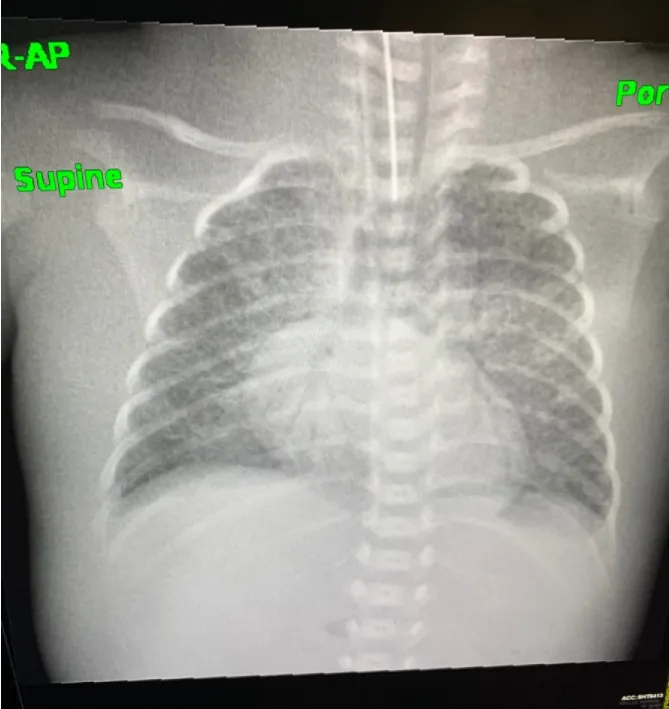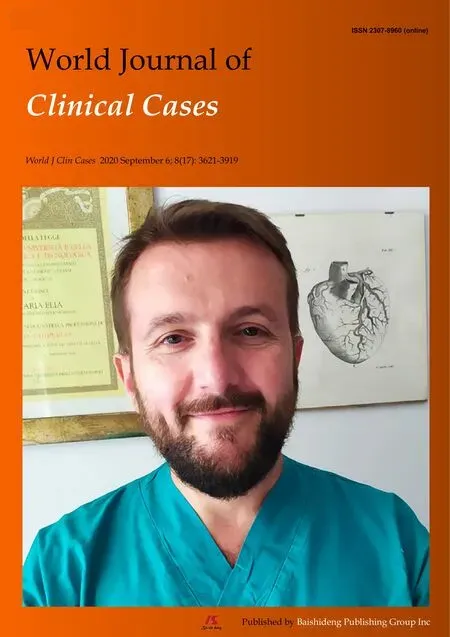Portal gas in neonates;is it always surgical? A case report
2020-09-18TariqIbrahimAltokhais
Tariq Ibrahim Altokhais
Tariq Ibrahim Altokhais,Division of Pediatric Surgery,Department of Surgery,College of Medicine,King Saud University,Riyadh 4545,Saudi Arabia
Abstract
Key words:Portal gas;Neonate;Necrotizing;Enterocolitis;Umbilical;Case report;Catheter
INTRODUCTION
Air in the portal venous system is very important in neonates,as it represents a late sign of necrotizing enterocolitis (NEC),and it is considered a relative indicator for surgical intervention[1,2].We report here a rare case of a preterm baby with air in the portal venous system due to malpositioning of an umbilical catheter rather than NEC.
CASE PRESENTATION
Chief complaints
A female neonate,with a post menstrual age of 27 wk and chronological age of 12 d,one of triplets and a product ofin vitrofertilization,with a birth weight of 850 g,was referred for surgery as a case of NEC after observing air in the portal venous system.
History of present illness
The neonate was delivered and shifted to the neonatal care unit for management.She underwent umbilical catheter insertion.There were neither clinical nor radiological signs of NEC.
History of past illness
No remarkable past medical or surgical history.
Physical examination
The patient appeared clinically well,showing normal activity,and was tolerating feeds.There was no abdominal wall discoloration or distention.
Laboratory examinations
There was no evidence of acidosis.C reactive protein was 2,platelets count was 200000,and white blood cells count was 12000.Capillary Blood gas was normal (pH:7.37,Bicarbonate:22).Blood sugar was 90 mg/dL and blood culture was negative.
Imaging examinations
There was no air in the portal venous system before the insertion of umbilical catheter(Figure 1).But air in the portal venous system was noticed in the abdominal radiograph which was obtained to check the tip of the umbilical catheter (Figure 2).There was no pneumatosis intestinalis and bowel loops were not dilated.The umbilical catheter was removed,and the air in the portal venous system disappeared in the subsequent abdominal radiograph,which was performed after 24 h of adjustment (Figure 3).
当时岳麓书院有百分之五十是由刘崐主持修建的。他亲自上书朝廷请拨银两,主持清代最后一次对岳麓书院的大规模修建。其结果是“因旧制而修复者十之五,新建者十之二,或增或改十之三”。他亲自撰写《重修岳麓书院记》,弘扬经世致用思想,稳固了湖南士人经世致用的学风。岳麓书院御书楼前长廊嵌存的《重修岳麓书院记》,便是刘崐撰写。
FINAL DIAGNOSIS
The final diagnosis was an air in the portal venous system due to malpositioning of an umbilical catheter.
TREATMENT
The umbilical catheter was removed and air disappeared.
OUTCOME AND FOLLOW-UP
The infant remained stable with no complication.She was managed medically and discharged home when her weight reached 1.8 kg.

Figure 1 Abdominal radiograph before umbilical catheter insertion.

Figure 2 Abdominal radiograph showing portal gas (arrows) due to malposition of umbilical catheter (arrow head),and an incidental finding of right main bronchus intubation (asterisk) causing left sided atelectasis.

Figure 3 Abdominal radiograph after umbilical catheter removal.
DISCUSSION
Hepatic portal venous gas was first described by Wolfeet al[3]in neonates in 1955.There are many underlying abdominal conditions associated with portal venous gas,ranging from benign to fatal conditions[4].When this finding is present with NEC,the infant is classified as at-risk with a high mortality rate (56%-90%) and might need surgical intervention[1,5].Our case had no clinical or radiological signs of NEC;thus,she was observed and did not require surgical intervention.
The hepatic portal gas noticed in our case was due to improper umbilical catheter placement.Umbilical vascular catheter placement in neonates was first reported in 1947[6].Although they are commonly used in the neonatal period,umbilical catheters are frequently malpositioned or associated with complications[7].If the catheter is malpositioned,there can be complications such as perforation into the peritoneal cavity,perforation into the urachus,hepatic laceration,displacement of the thrombus in the ductus venosus,pulmonary infarction,perforation into the pericardium,a retained catheter fragment,lung abscess,splenic vein thrombosis,and calcification of the portal vein or umbilical vein[8].
Hepatic portal venous gas in radiography must be differentiated from gas in the biliary tree (pneumobilia).The classic radiological finding of portal venous gas is branching radiolucency following venous blood flow into the liver and extending to within 2 cm beneath the liver capsule.In contrast,pneumobilia is classically seen as central radiolucency following the biliary anatomy and not extending peripherally[1,4].
CONCLUSION
Hepatic portal venous gas in infants without signs of NEC could result from malposition of Umbilical venous catheter,and in that case,should be managed medically,with no need for surgical intervention.
猜你喜欢
杂志排行
World Journal of Clinical Cases的其它文章
- Diagnosis and treatment of an elderly patient with 2019-nCoV pneumonia and acute exacerbation of chronic obstructive pulmonary disease in Gansu Province:A case report
- Active surveillance in metastatic pancreatic neuroendocrine tumors:A 20-year single-institutional experience
- Shear wave elastography may be sensitive and more precise than transient elastography in predicting significant fibrosis
- Diagnosis and treatment of mixed infection of hepatic cystic and alveolar echinococcosis:Four case reports
- Surgical strategy used in multilevel cervical disc replacement and cervical hybrid surgery:Four case reports
- Gallbladder sarcomatoid carcinoma:Seven case reports
